Assessing Climate Change Trends and Their Relationships with Alpine Vegetation and Surface Water Dynamics in the Everest Region, Nepal
Abstract
:1. Introduction
2. Materials and Methods
2.1. Site Description
2.2. Climate Data
2.2.1. Temperature
2.2.2. Precipitation
2.3. Surface Water
2.3.1. Glacial Lakes
2.3.2. Streamflow
2.4. Alpine Vegetation
2.4.1. Spatial Change Detection
2.4.2. NDVI Change Detection
3. Results
3.1. Trends in Climate Variables
3.1.1. Temperature Trend
3.1.2. Precipitation Trend
3.2. Surface Water
3.2.1. Glacial Lake Changes
3.2.2. Streamflow Trend
3.3. Alpine Vegetation
3.3.1. Spatial Change Detection
3.3.2. NDVI Change Detection
3.4. Alpine Region Change and Its Relationship with Climate Variables
4. Discussion
4.1. Climate Trend
4.2. Surface Water Dynamics
4.3. Alpine Vegetation Dynamics
5. Conclusions
Author Contributions
Funding
Data Availability Statement
Acknowledgments
Conflicts of Interest
References
- Woodward, F.I.; Lomas, M.R.; Kelly, C.K. Global climate and the distribution of plant biomes. Philos. Trans. R. Soc. B Biol. Sci. 2004, 359, 1465–1476. [Google Scholar] [CrossRef] [PubMed] [Green Version]
- Bailey, R.G. Ecoregions: The Ecosystem Geography of the Oceans and Continents; Springer: New York, NY, USA, 2014; ISBN 9781493905232. [Google Scholar]
- Thornthwaite, C.W. An approach toward a rational classification of climate. Geogr. Rev. 1948, 38, 55–94. [Google Scholar] [CrossRef]
- Korner, C.; Ohsawa, M. Mountain systems. In Ecosystems and Human Well-Being: Current State and Trends; Island Press: Washington, DC, USA, 2005; Volume 1. [Google Scholar]
- Körner, C.; Paulsen, J.; Spehn, E.M. A definition of mountains and their bioclimatic belts for global comparisons of biodiversity data. Alp. Bot. 2011, 121, 73–78. [Google Scholar] [CrossRef] [Green Version]
- Government of Nepal Nepal Biodiversity Strategy. Available online: https://www.cbd.int/doc/world/np/np-nbsap-01-en.pdf (accessed on 30 July 2021).
- Viviroli, D.; Dürr, H.H.; Messerli, B.; Meybeck, M.; Weingartner, R. Mountains of the world, water towers for humanity: Typology, mapping, and global significance. Water Resour. Res. 2007, 43, 1–13. [Google Scholar] [CrossRef] [Green Version]
- PAN. Temporal and Spatial Variability of Climate Change over Nepal. Available online: https://www.dhm.gov.np/uploads/climatic/467608975Observed%20Climate%20Trend%20Analysis%20Report_2017_Final.pdf (accessed on 30 July 2021).
- ICIMOD/GoN. Nepal Biodiversity Resource Book: Protected Areas, Ramsar Sites, and World Heritage Sites. Available online: https://lib.icimod.org/record/7560 (accessed on 30 July 2021).
- Dixit, A.; Upadhya, M.; Dixit, K.; Pokhrel, A.; Rai, D.R. Living with Water Stress in the Hills of the Koshi Basin, Nepal. Available online: https://www.preventionweb.net/publications/view/12786 (accessed on 30 July 2021).
- Jha, R. Total run-of-river type hydropower potential of Nepal. Hydro Nepal J. Water Energy Environ. 2010, 7, 8–13. [Google Scholar] [CrossRef]
- Masson-Delmotte, V.; Zhai, P.; Pörtner, H.O.; Roberts, D.; Skea, J.; Shukla, P.R.; Pirani, A.; Moufouma-Okia, W.; Péan, C.; Pidcock, R. Global Warming of 1.5 °C. An IPCC Special Report on the Impacts of Global Warming of 1.5 °C above Pre-Industrial Levels and Related Global Greenhouse Gas Emission Pathways, in the Context of Strengthening the Global Response to the Threat of Climate Change. Available online: https://www.ipcc.ch/site/assets/uploads/sites/2/2019/06/SR15_Full_Report_High_Res.pdf (accessed on 30 July 2021).
- Shrestha, A.B.; Wake, C.P.; Mayewski, P.A.; Dibb, J.E. Maximum temperature trends in the Himalaya and its vicinity: An analysis based on temperature records from Nepal for the period 1971–1994. J. Clim. 1999, 12, 2775–2786. [Google Scholar] [CrossRef] [Green Version]
- Ernakovich, J.G.; Hopping, K.A.; Berdanier, A.B.; Simpson, R.T.; Kachergis, E.J.; Steltzer, H.; Wallenstein, M.D. Predicted responses of arctic and alpine ecosystems to altered seasonality under climate change. Glob. Chang. Biol. 2014, 20, 3256–3269. [Google Scholar] [CrossRef]
- Zhang, Y.; Gao, J.; Liu, L.; Wang, Z.; Ding, M.; Yang, X. NDVI-based vegetation changes and their responses to climate change from 1982 to 2011: A case study in the Koshi River Basin in the middle Himalayas. Glob. Planet. Chang. 2013, 108, 139–148. [Google Scholar] [CrossRef]
- Liu, L.; Wang, Y.; Wang, Z.; Li, D.; Zhang, Y.; Qin, D. Elevation-dependent decline in vegetation greening rate driven by increasing dryness based on three satellite NDVI datasets on the Tibetan Plateau. Ecol. Indic. 2019, 107, 105569. [Google Scholar] [CrossRef]
- Baniya, B.; Tang, Q.; Koirala, M.; Rijal, K.; Kattel, G. Growing season vegetation dynamics based on NDVI and the driving forces in Nepal during 1982–2015. For. J. Inst. For. Nepal 2020, 17, 1–22. [Google Scholar] [CrossRef]
- Wu, X.; Sun, X.; Wang, Z.; Zhang, Y.; Liu, Q.; Zhang, B.; Paudel, B.; Xie, F. Vegetation changes and their response to global change based on NDVI in the Koshi River Basin of central Himalayas since 2000. Sustainability 2020, 12, 6644. [Google Scholar] [CrossRef]
- Anderson, K.; Fawcett, D.; Cugulliere, A.; Benford, S.; Jones, D.; Leng, R. Vegetation expansion in the subnival Hindu Kush Himalaya. Glob. Chang. Biol. 2020, 26, 1608–1625. [Google Scholar] [CrossRef] [PubMed] [Green Version]
- Gao, Q.; Guo, Y.; Xu, H.; Ganjurjav, H.; Li, Y.; Wan, Y.; Qin, X.; Ma, X.; Liu, S. Climate change and its impacts on vegetation distribution and net primary productivity of the alpine ecosystem in the Qinghai-Tibetan Plateau. Sci. Total Environ. 2016, 554–555, 34–41. [Google Scholar] [CrossRef] [PubMed]
- Brandt, J.S.; Haynes, M.A.; Kuemmerle, T.; Waller, D.M.; Radeloff, V.C. Regime shift on the roof of the world: Alpine meadows converting to shrublands in the southern Himalayas. Biol. Conserv. 2013, 158, 116–127. [Google Scholar] [CrossRef]
- Mohapatra, J.; Singh, C.P.; Tripathi, O.P.; Pandya, H.A. Remote sensing of alpine treeline ecotone dynamics and phenology in Arunachal Pradesh Himalaya. Int. J. Remote Sens. 2019, 40, 7986–8009. [Google Scholar] [CrossRef]
- Mishra, N.B.; Mainali, K.P. Greening and browning of the Himalaya: Spatial patterns and the role of climatic change and human drivers. Sci. Total Environ. 2017, 587–588, 326–339. [Google Scholar] [CrossRef]
- Bokhorst, S.; Bjerke, J.W.; Melillo, J.; Callaghan, T.V.; Phoenix, G.K. Impacts of extreme winter warming events on litter decomposition in a sub-Arctic heathland. Soil Biol. Biochem. 2010, 42, 611–617. [Google Scholar] [CrossRef] [Green Version]
- Nie, Y.; Liu, Q.; Liu, S. Glacial lake expansion in the Central Himalayas by Landsat Images, 1990–2010. PLoS ONE 2013, 8, e83973. [Google Scholar] [CrossRef] [PubMed] [Green Version]
- Khadka, N.; Zhang, G.; Thakuri, S. Glacial lakes in the Nepal Himalaya: Inventory and decadal dynamics (1977–2017). Remote Sens. 2018, 10, 1913. [Google Scholar] [CrossRef] [Green Version]
- Bajracharya, S.R.; Mool, P. Glaciers, glacial lakes and glacial lake outburst floods in the Mount Everest region, Nepal. Ann. Glaciol. 2009, 50, 81–86. [Google Scholar] [CrossRef] [Green Version]
- Garrard, R.; Kohler, T.; Price, M.F.; Byers, A.C.; Sherpa, A.R.; Maharjan, G.R. Land use and land cover change in Sagarmatha National Park, a world heritage site in the Himalayas of Eastern Nepal. Mt. Res. Dev. 2016, 36, 299. [Google Scholar] [CrossRef]
- DHM. Observed Climate Trend Analysis in the Districts and Physiographic Regions of Nepal (1971–2014); Department of Hydrology and Meteorology: Kathmandu, Nepal, 2017. [Google Scholar]
- ICIMOD. Climatic and Hydrological Atlas of Nepal; International Centre for Integrated Mountain Development: Kathmandu, Nepal, 1996. [Google Scholar]
- Zhai, P.; Sun, A.; Ren, F.; Liu, X.; Gao, B.; Zhang, Q. Changes of climate extremes in China. Clim. Chang. 1999, 42, 203–218. [Google Scholar] [CrossRef]
- Zubieta, R.; Saavedra, M.; Silva, Y.; Giráldez, L. Spatial analysis and temporal trends of daily precipitation concentration in the mantaro river basin: Central Andes of Peru. Stoch. Environ. Res. Risk Assess. 2017, 31, 1305–1318. [Google Scholar] [CrossRef]
- Chapman, W.L.; Walsh, J.E. Recent variations of sea ice and air temperature in high latitudes. Am. Meteorol. Soc. 1993, 74, 33–47. [Google Scholar] [CrossRef] [Green Version]
- Klein Tank, A.M.G.; Wijngaard, J.B.; Können, G.P.; Böhm, R.; Demarée, G.; Gocheva, A.; Mileta, M.; Pashiardis, S.; Hejkrlik, L.; Kern-Hansen, C.; et al. Daily dataset of 20th-century surface air temperature and precipitation series for the European Climate Assessment. Int. J. Climatol. 2002, 22, 1441–1453. [Google Scholar] [CrossRef]
- Haylock, M.R.; Hofstra, N.; Klein Tank, A.M.G.; Klok, E.J.; Jones, P.D.; New, M. A European daily high-resolution gridded data set of surface temperature and precipitation for 1950–2006. J. Geophys. Res. 2008, 113, 1950–2006. [Google Scholar] [CrossRef] [Green Version]
- Hersbach, H.; Bell, B.; Berrisford, P.; Hirahara, S.; Horányi, A.; Muñoz-Sabater, J.; Nicolas, J.; Peubey, C.; Radu, R.; Schepers, D.; et al. The ERA5 global reanalysis. Q. J. R. Meteorol. Soc. 2020, 146, 1999–2049. [Google Scholar] [CrossRef]
- Zhu, J.; Xie, A.; Qin, X.; Wang, Y.; Xu, B.; Wang, Y. An assessment of ERA5 reanalysis for antarctic near-surface air temperature. Atmosphere 2021, 12, 217. [Google Scholar] [CrossRef]
- Jakovlev, A.R.; Smyshlyaev, S.P.; Galin, V.Y. Interannual variability and trends in sea surface temperature, lower and middle atmosphere temperature at different latitudes for 1980–2019. Atmosphere 2021, 12, 454. [Google Scholar] [CrossRef]
- Wang, X.L. Penalized maximal F test for detecting undocumented mean shift without trend change. J. Atmos. Ocean. Technol. 2008, 25, 368–384. [Google Scholar] [CrossRef]
- Hamed, K.H.; Rao, A.R. A modified Mann-Kendall trend test for autocorrelated data. J. Hydrol. 1998, 204, 182–196. [Google Scholar] [CrossRef]
- Mann, H.B. Non-parametric test against trend. Econometrica 1945, 13, 245–259. [Google Scholar] [CrossRef]
- Tartari, G.; Verza, G.; Bertolami, L. Meteorological data at the Pyramid Observatory Laboratory (Khumbu Valley, Sagarmatha National Park, Nepal). J. Limnol. 1998, 57, 23–40. [Google Scholar]
- Talchabhadel, R.; Karki, R.; Parajuli, B. Intercomparison of precipitation measured between automatic and manual precipitation gauge in Nepal. Measurement 2016, 106, 264–273. [Google Scholar] [CrossRef]
- WMO Guide to the Global Observing System: WMO-No 488; World Meteorological Organization: Geneva, Switzerland, 2017.
- Eischeid, J.K.; Bruce Baker, C.; Karl, T.R.; Diaz, H.F. The quality control of long-term climatological data using objective data analysis. J. Appl. Meteorol. 1995, 34, 2787–2795. [Google Scholar] [CrossRef] [Green Version]
- Pekel, J.F.; Cottam, A.; Gorelick, N.; Belward, A.S. High-resolution mapping of global surface water and its long-term changes. Nature 2016, 540, 418–422. [Google Scholar] [CrossRef] [PubMed]
- Gorelick, N.; Hancher, M.; Dixon, M.; Ilyushchenko, S.; Thau, D.; Moore, R. Google earth engine: Planetary-scale geospatial analysis for everyone. Remote Sens. Environ. 2017, 202, 18–27. [Google Scholar] [CrossRef]
- Huggel, C.; Kääb, A.; Haeberli, W.; Teysseire, P.; Paul, F. Remote sensing based assessment of hazards from glacier lake outbursts: A case study in the Swiss Alps. Can. Geotech. J. 2002, 39, 316–330. [Google Scholar] [CrossRef] [Green Version]
- Savéan, M.; Delclaux, F.; Chevallier, P.; Wagnon, P.; Gonga-Saholiariliva, N.; Sharma, R.; Neppel, L.; Arnaud, Y. Water budget on the Dudh Koshi River (Nepal): Uncertainties on precipitation. J. Hydrol. 2015, 531, 850–862. [Google Scholar] [CrossRef]
- Brockwell, P.J.; Davis, R.A. Introduction to Time Series and Forecasting; Springer: Berlin/Heidelberg, Germany, 2002; ISBN 9780387781884. [Google Scholar]
- Congalton, R.G.; Green, K. Assessing the Accuracy of Remotely Sensed Data: Principles and Practices; CRC Press: Boca Raton, FL, USA, 2019; ISBN 9781498776660. [Google Scholar]
- Storey, J.C.; Choate, M.J. Landsat-5 bumper-mode geometric correction. IEEE Trans. Geosci. Remote Sens. 2004, 42, 2695–2703. [Google Scholar] [CrossRef]
- Markham, B.L.; Storey, J.C.; Williams, D.L.; Irons, J.R. Landsat sensor performance: History and current status. IEEE Trans. Geosci. Remote Sens. 2004, 42, 2691–2694. [Google Scholar] [CrossRef]
- Churkina, G.; Running, S.W. Contrasting climatic controls on the estimated productivity of global terrestrial biomes. Ecosystems 1998, 1, 206–215. [Google Scholar] [CrossRef]
- Nemani, R.R.; Keeling, C.D.; Hashimoto, H.; Jolly, W.M.; Piper, S.C.; Tucker, C.J.; Myneni, R.B.; Running, S.W. Climate-driven increases in global terrestrial net primary production from 1982 to 1999. Science 2003, 300, 1560–1563. [Google Scholar] [CrossRef] [PubMed] [Green Version]
- Balling, R.C.; Michaels, P.J.; Knappenberger, P.C. Analysis of winter and summer warming rates in gridded temperature time series. Clim. Res. 1998, 9, 175–181. [Google Scholar] [CrossRef] [Green Version]
- Schuerings, J.; Beierkuhnlein, C.; Grant, K.; Jentsch, A.; Malyshev, A.; Peñuelas, J.; Sardans, J.; Kreyling, J. Absence of soil frost affects plant-soil interactions in temperate grasslands. Plant. Soil 2013, 371, 559–572. [Google Scholar] [CrossRef]
- Kreyling, J.; Grant, K.; Hammerl, V.; Arfin-Khan, M.A.S.; Malyshev, A.V.; Peñuelas, J.; Pritsch, K.; Sardans, J.; Schloter, M.; Schuerings, J.; et al. Winter warming is ecologically more relevant than summer warming in a cool-temperate grassland. Sci. Rep. 2019, 9, 14632. [Google Scholar] [CrossRef] [Green Version]
- Parmesan, C.; Yohe, G. A globally coherent fingerprint of climate change impacts across natural systems. Nature 2003, 421, 37–42. [Google Scholar] [CrossRef]
- Salerno, F.; Guyennon, N.; Thakuri, S.; Viviano, G.; Romano, E.; Vuillermoz, E.; Cristofanelli, P.; Stocchi, P.; Agrillo, G.; Ma, Y.; et al. Weak precipitation, warm winters and springs impact glaciers of south slopes of Mt. Everest (central Himalaya) in the last 2 decades (1994–2013). Cryosphere 2015, 9, 1229–1247. [Google Scholar] [CrossRef] [Green Version]
- Shrestha, A.B.; Bajracharya, S.R.; Sharma, A.R.; Duo, C.; Kulkarni, A. Observed trends and changes in daily temperature and precipitation extremes over the Koshi river basin 1975–2010. Int. J. Climatol. 2017, 37, 1066–1083. [Google Scholar] [CrossRef] [Green Version]
- Zemp, M.; Huss, M.; Thibert, E.; Eckert, N.; McNabb, R.; Huber, J.; Barandun, M.; Machguth, H.; Nussbaumer, S.U.; Gärtner-Roer, I.; et al. Global glacier mass changes and their contributions to sea-level rise from 1961 to 2016. Nature 2019, 568, 382–386. [Google Scholar] [CrossRef]
- Bajracharya, S.R.; Mool, P.K.; Shrestha, B.R. Impact of Climate Change on Himalayan Glaciers and Glacial Lakes: Case Studies on GLOF and Associated Hazards in Nepal and Bhutan; International Centre for Integrated Mountain Development (ICIMOD): Kathmandu, Nepal; United Nations Environment Programme (UNEP): Nairobi, Kenya, 2007. [Google Scholar]
- Salerno, F.; Thakuri, S.; D’Agata, C.; Smiraglia, C.; Manfredi, E.C.; Viviano, G.; Tartari, G. Glacial lake distribution in the Mount Everest region: Uncertainty of measurement and conditions of formation. Glob. Planet. Chang. 2012, 92–93, 30–39. [Google Scholar] [CrossRef]
- Wang, X.; Siegert, F.; Zhou, A.G.; Franke, J. Glacier and glacial lake changes and their relationship in the context of climate change, Central Tibetan Plateau 1972–2010. Glob. Planet. Chang. 2013, 111, 246–257. [Google Scholar] [CrossRef]
- Water and Energy Commission Secretariat. Water Resources of Nepal in the Context of Climate Change; Water and Energy Commission Secretariat: Kathmandu, Nepal, 2011. [Google Scholar]
- Gautam, M.R.; Acharya, K. Streamflow trends in Nepal. Hydrol. Sci. J. 2012, 57, 344–357. [Google Scholar] [CrossRef]
- Shi, C.; Sun, G.; Zhang, H.; Xiao, B.; Ze, B.; Zhang, N.; Wu, N. Effects of warming on chlorophyll degradation and carbohydrate accumulation of alpine herbaceous species during plant senescence on the tibetan plateau. PLoS ONE 2014, 9, e107874. [Google Scholar] [CrossRef] [PubMed]
- Li, P.; Zhu, Q.; Peng, C.; Zhang, J.; Wang, M.; Zhang, J.; Ding, J.; Zhou, X. Change in Autumn Vegetation Phenology and the Climate Controls From 1982 to 2012 on the Qinghai–Tibet Plateau. Front. Plant. Sci. 2020, 10, 1677. [Google Scholar] [CrossRef] [PubMed] [Green Version]
- Pandey, P.; Kulkarni, A.V.; Venkataraman, G. Remote sensing study of snowline altitude at the end of melting season, Chandra-Bhaga basin, Himachal Pradesh, 1980–2007. Geocarto Int. 2013, 28, 311–322. [Google Scholar] [CrossRef]
- Chen, X.; An, S.; Inouye, D.W.; Schwartz, M.D. Temperature and snowfall trigger alpine vegetation green-up on the world’s roof. Glob. Chang. Biol. 2015, 21, 3635–3646. [Google Scholar] [CrossRef]
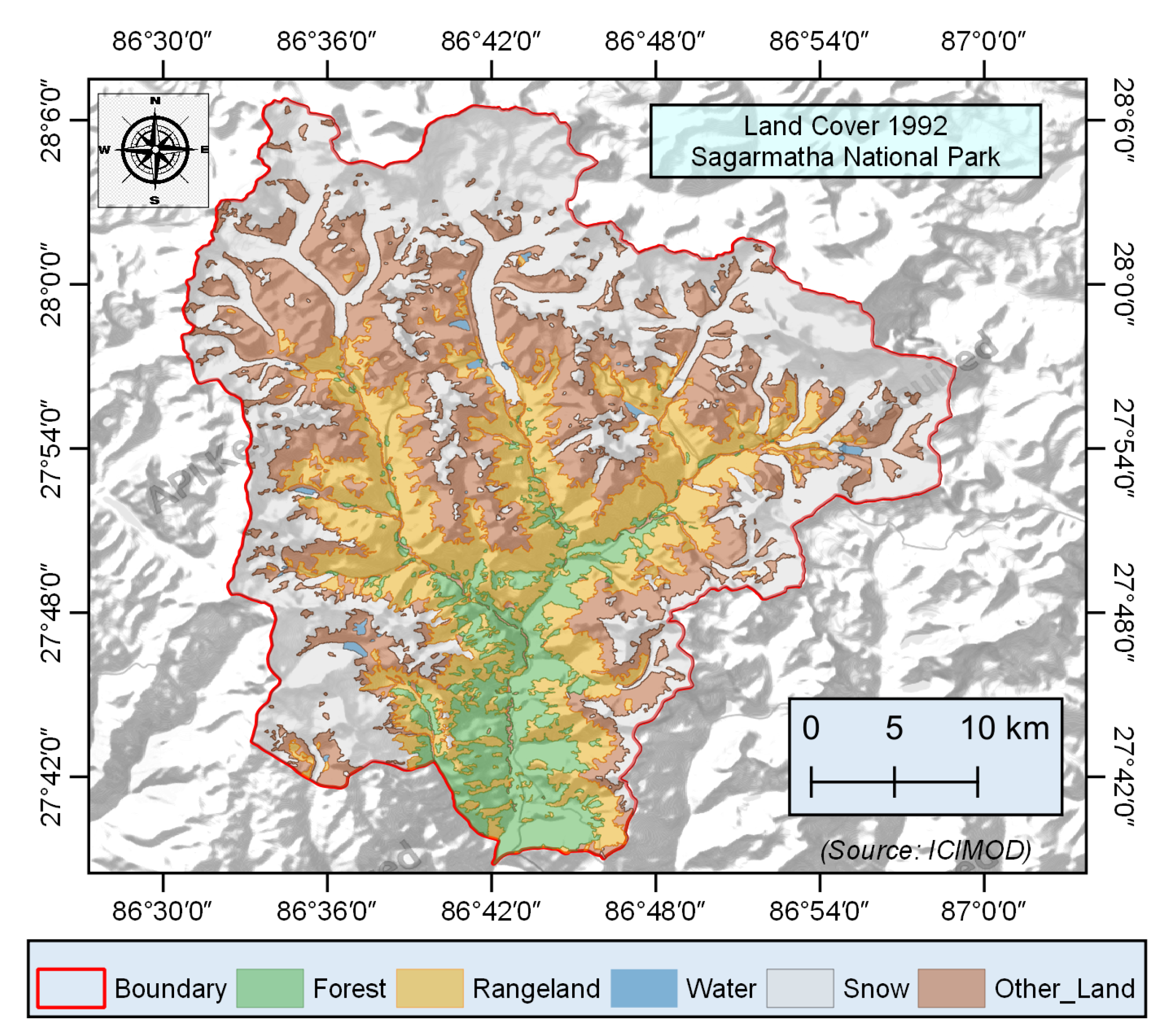
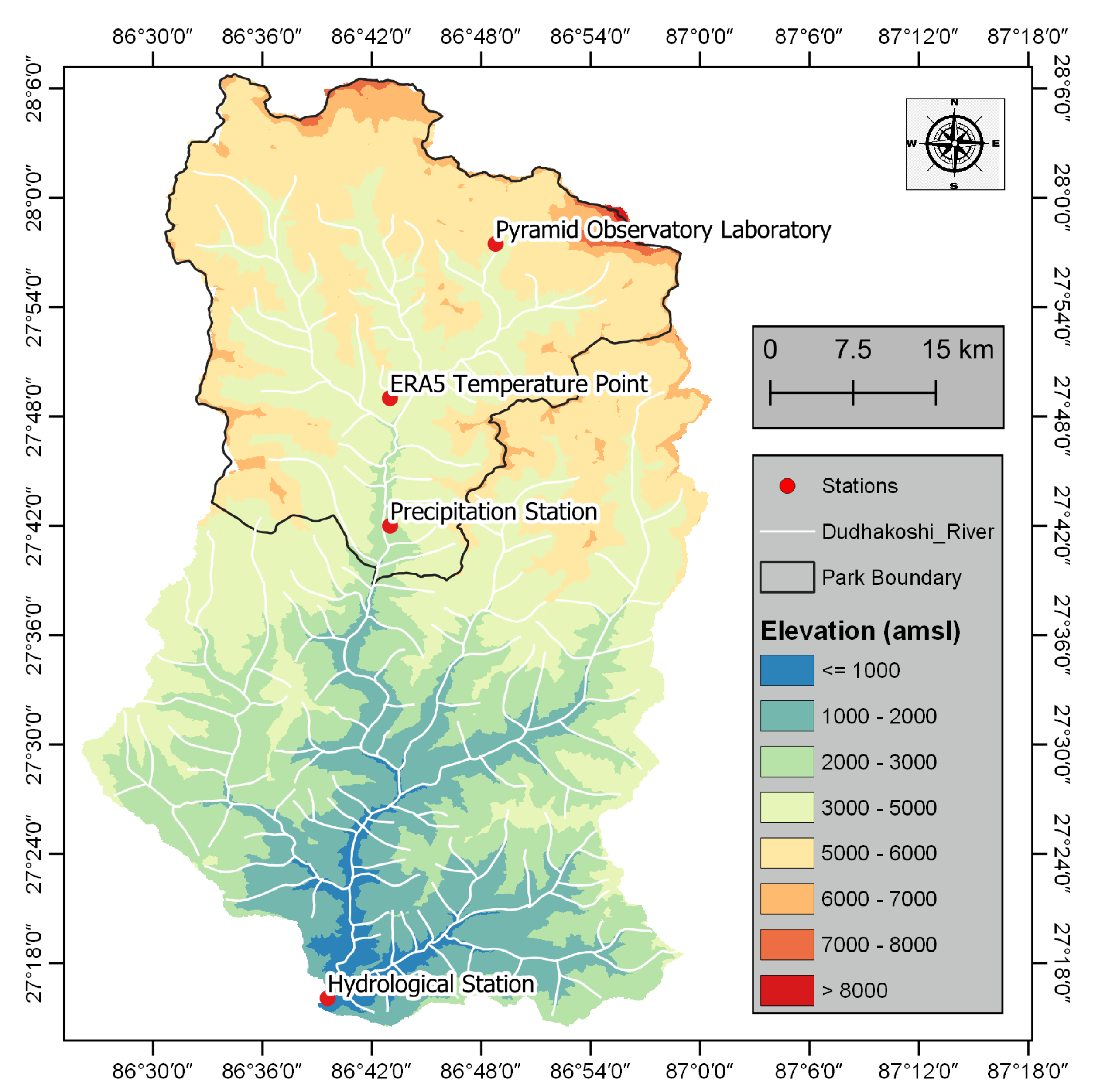
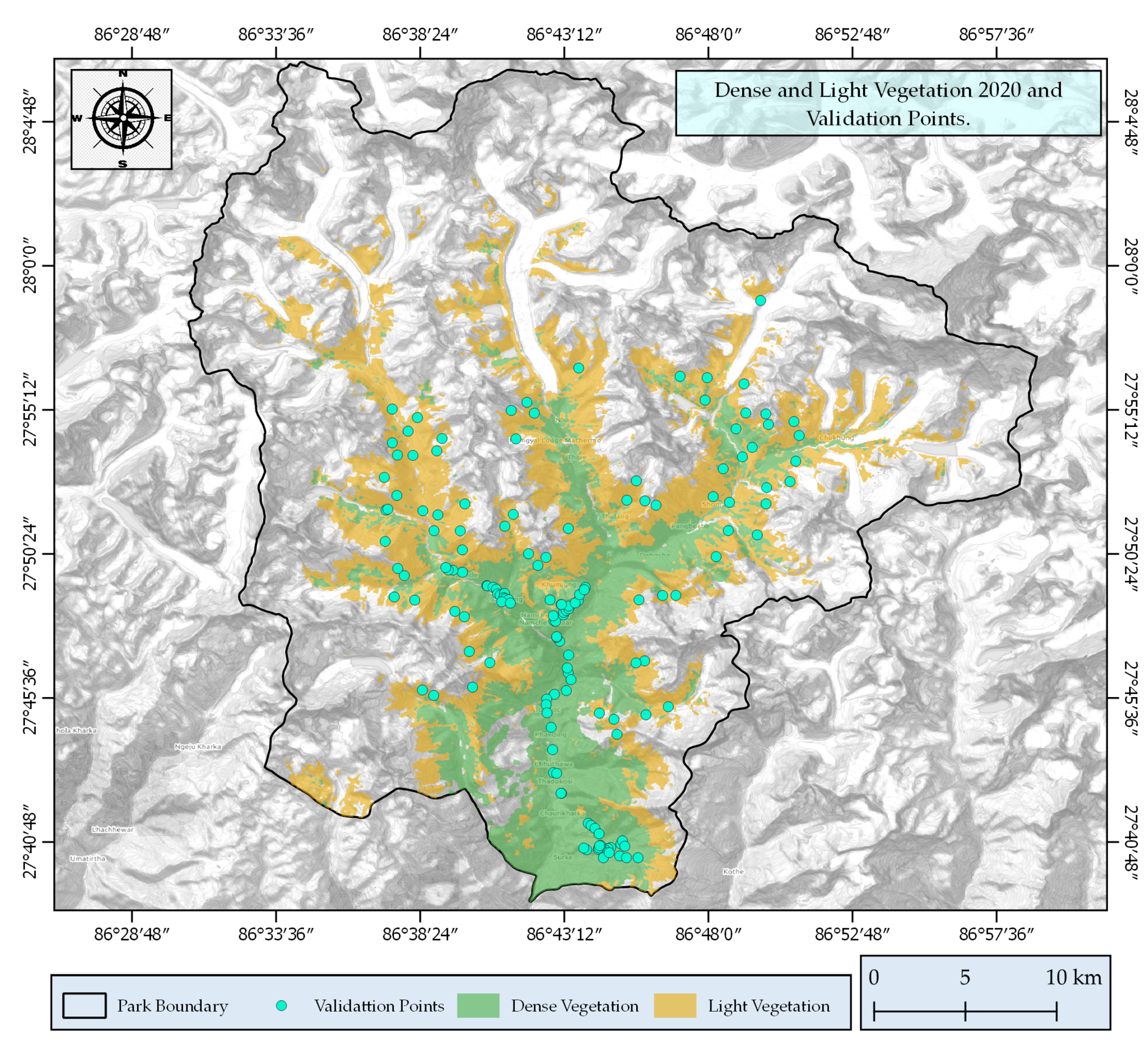

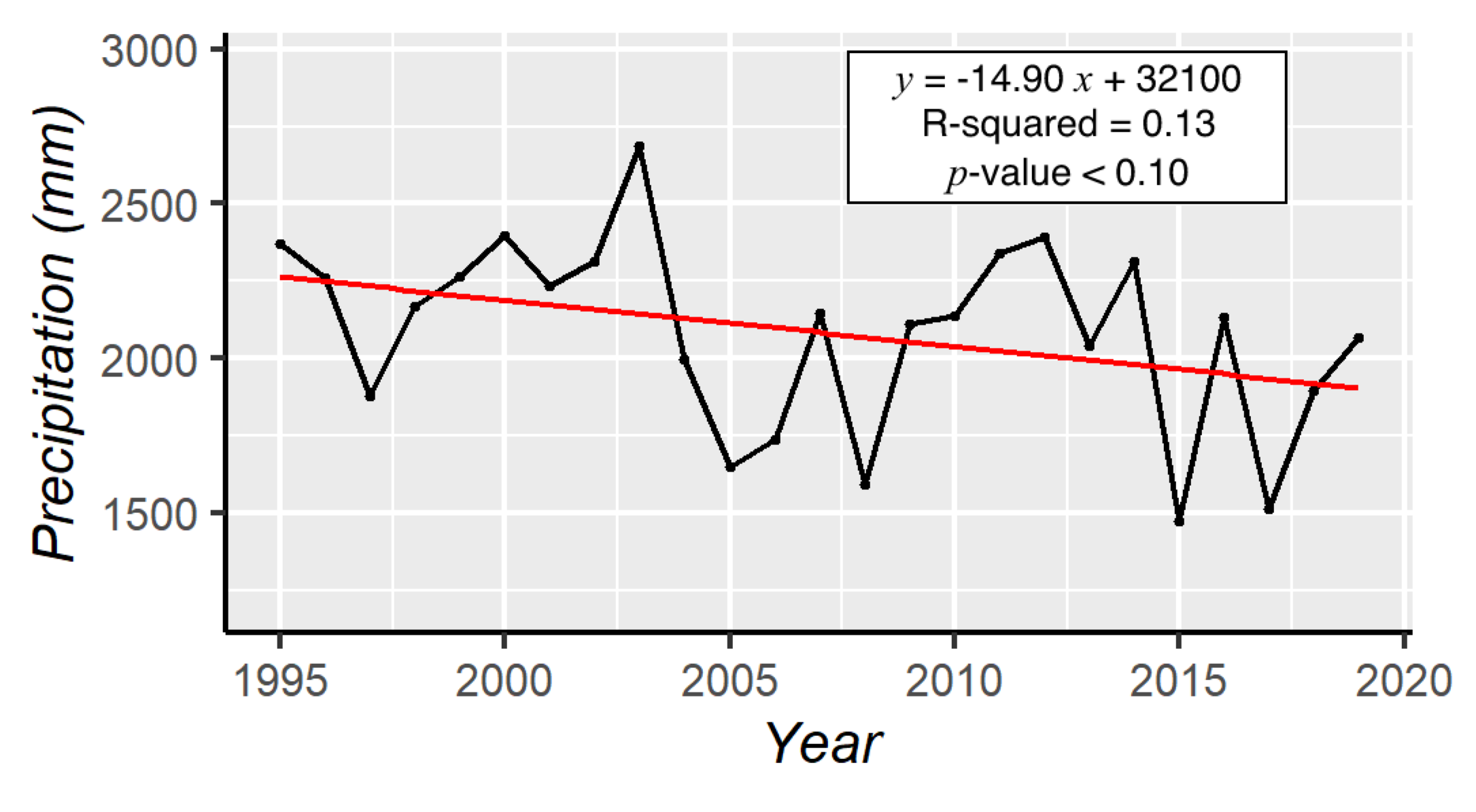


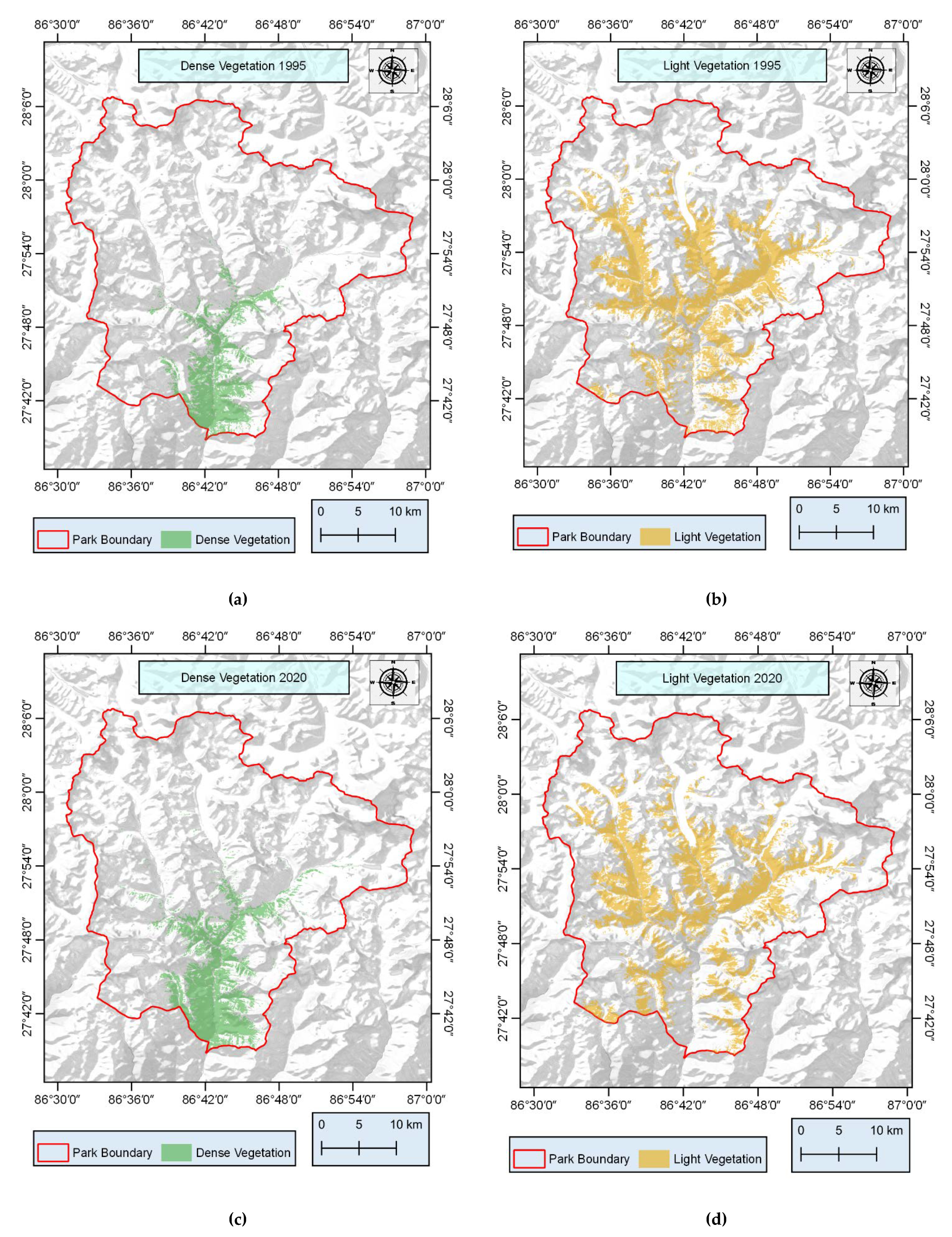
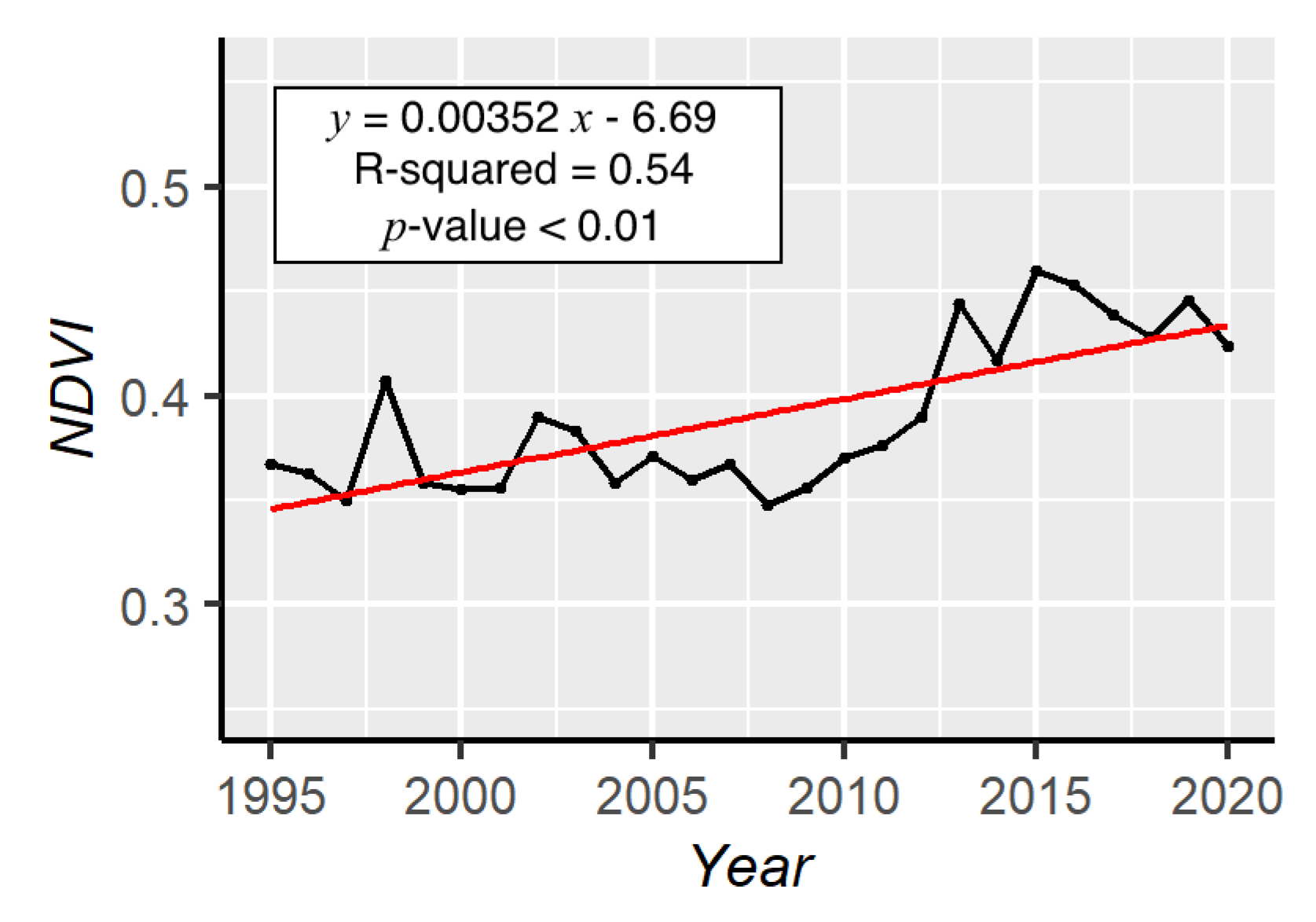
| Station ID | Station/Site Name | Type | Latitude | Longitude | Elevation (m) | Start Year | End Year |
|---|---|---|---|---|---|---|---|
| 1202 | Chaurikharka | Precipitation | 27° 42′ 00″ | 86° 43′ 00″ | 2619 | 1 January 1995 | 31 December 2019 |
| 670 | Rabuwa Bazar | Discharge | 27° 16′ 00″ | 86° 39′ 35″ | 460 | 1 January 1995 | 12 December 2015 |
| - | Khumjung | Temperature | 27° 49′ 00″ | 86° 43′ 00″ | 3800 | 1 January 1995 | 12 December 2019 |
| Series | Mean Temperature | Maximum Temperature | Minimum Temperature | ||||||
|---|---|---|---|---|---|---|---|---|---|
| z-Value | Tau | p | z-Value | Tau | p | z-Value | Tau | p | |
| Winter | 1.91 | 0.20 | 0.06 | 1.66 | 0.24 | 0.10 | 3.18 | 0.29 | <0.01 |
| Spring | 0.54 | 0.08 | 0.59 | 1.08 | 0.16 | 0.28 | 1.91 | 0.27 | 0.06 |
| Summer | 3.79 | 0.54 | <0.01 | 3.29 | 0.47 | <0.01 | 3.12 | 0.45 | <0.01 |
| Autumn | 1.13 | 0.18 | 0.26 | 1.97 | 0.28 | 0.05 | 1.41 | 0.22 | 0.16 |
| Annual | 1.78 | 0.26 | 0.07 | 2.27 | 0.33 | 0.02 | 2.46 | 0.35 | 0.01 |
| Climate Variables | Season Variables (y) | Regression Line | R2 | p-Value |
|---|---|---|---|---|
| Mean Temperature | Winter | y = 0.0579x − 123 | R2 = 0.08 | ns |
| Spring | y = 0.0178x − 35.60 | R2 = 0.02 | ns | |
| Summer | y = 0.0287x − 49.40 | R2 = 0.46 | *** | |
| Autumn | y = 0.0279x − 53.60 | R2 = 0.09 | ns | |
| Maximum Temperature | Winter | y = 0.078x − 157 | R2 = 0.13 | * |
| Spring | y = 0.0181x − 31.50 | R2 = 0.02 | ns | |
| Summer | y = 0.0343x − 57.80 | R2 = 0.40 | *** | |
| Autumn | y = 0.0358x − 65 | R2 = 0.17 | ** | |
| Minimum Temperature | Winter | y = 0.0915x − 196 | R2 = 0.14 | * |
| Spring | y = 0.0482x − 102 | R2 = 0.10 | ns | |
| Summer | y = 0.0341x − 62.90 | R2 = 0.38 | *** | |
| Autumn | y = 0.0467x − 95.50 | R2 = 0.14 | * | |
| Precipitation | Winter | y = −1.49x + 3030 | R2 = 0.06 | ns |
| Spring | y = 0.973x − 1750 | R2 = 0.02 | ns | |
| Summer | y = −12x + 25,800 | R2 = 0.09 | ns | |
| Autumn | y = −2.46x + 4990 | R2 = 0.11 | ns | |
| Average Streamflow | Winter | y = 0.29x − 534 | R2 = 0.09 | ns |
| Spring | y = −2.64x + 5440 | R2 = 0.22 | ** | |
| Summer | y = −11.4x + 23,400 | R2 = 0.34 | *** | |
| Autumn | y = −2.48x + 5110 | R2 = 0.35 | *** | |
| Maximum Streamflow | Winter | y = 0.0713x − 87.60 | R2 ≤ 0.01 | ns |
| Spring | y = −1.07x + 2230 | R2 = 0.10 | ns | |
| Summer | y = 1.05x − 1080 | R2 ≤ 0.01 | ns | |
| Autumn | y = −2.19x + 4630 | R2 = 0.02 | ns | |
| Minimum Streamflow | Winter | y = 0.0779x − 115 | R2 = 0.01 | ns |
| Autumn | y = −0.656x + 1350 | R2 = 0.22 | ** | |
| Summer | y = −4.76x + 9800 | R2 = 0.39 | *** | |
| Autumn | y = −0.0455x + 182 | R2 ≤ 0.01 | ns | |
| Mean NDVI | Winter | y = 0.00338x − 6.45 | R2 = 0.48 | *** |
| Spring | y = 0.00309x − 5.87 | R2 = 0.32 | *** | |
| Summer | y = 0.0026x − 4.76 | R2 = 0.25 | *** | |
| Autumn | y = 0.00506x − 9.74 | R2 = 0.54 | *** | |
| Glacial Lake Area | Winter | y = 0.0784x − 154 | R2 = 0.19 | ** |
| Spring | y = 0.045x − 87.40 | R2 = 0.10 | ns | |
| Summer | y = 0.0346x − 63.90 | R2 = 0.07 | ns | |
| Autumn | y = 0.151x − 295 | R2 = 0.43 | *** |
| Year | Mean Temperature (Reanalysis vs. Observation) | Max. Temperature (Reanalysis vs. Observation) | Min. Temperature (Reanalysis vs. Observation) | |||
|---|---|---|---|---|---|---|
| t-Value | p-Value | t-Value | p-Value | t-Value | p-Value | |
| 1995 | −1.23 | 0.23 | −1.15 | 0.26 | −0.86 | 0.40 |
| Series | Precipitation | Glacial Lake Area | Mean NDVI | ||||||
|---|---|---|---|---|---|---|---|---|---|
| z-Value | Tau | p | z-Value | Tau | p | z-Value | Tau | p | |
| Winter | −2.44 | −0.27 | 0.01 | 1.64 | 0.24 | 0.10 | 2.23 | 0.45 | 0.03 |
| Spring | 0.74 | 0.09 | 0.46 | 1.29 | 0.18 | 0.20 | 2.67 | 0.38 | 0.01 |
| Summer | −1.71 | −0.20 | 0.09 | 0.90 | 0.10 | 0.37 | 2.42 | 0.30 | 0.02 |
| Autumn | −2.06 | −0.32 | 0.04 | 3.69 | 0.53 | <0.01 | 3.67 | 0.53 | <0.01 |
| Annual | −2.37 | −0.26 | 0.02 | 2.87 | 0.39 | <0.01 | 2.01 | 0.47 | 0.04 |
| Series | Average Streamflow | Maximum Streamflow | Minimum Streamflow | ||||||
|---|---|---|---|---|---|---|---|---|---|
| z-Value | Tau | p | z-Value | Tau | p | z-Value | Tau | p | |
| Winter | 1.24 | 0.18 | 0.22 | <0.01 | <0.01 | 1.00 | 0.07 | 0.01 | 0.95 |
| Spring | −4.31 | −0.36 | <0.01 | −3.51 | −0.31 | <0.01 | −2.43 | −0.35 | 0.02 |
| Summer | −2.34 | −0.47 | 0.02 | 0.54 | 0.08 | 0.59 | −3.06 | −0.44 | <0.01 |
| Autumn | −3.71 | −0.44 | <0.01 | −0.47 | −0.07 | 0.64 | <0.01 | <0.01 | 1.00 |
| Annual | −2.87 | −0.41 | <0.01 | −0.58 | −0.09 | 0.56 | −3.29 | −0.47 | <0.01 |
| Reference Data Set | User’s Accuracy | |||||
|---|---|---|---|---|---|---|
| Land Cover | Dense Vegetation | Light Vegetation | Other Classes | Total | ||
| Classified data set | Dense Vegetation | 61 | 0 | 0 | 61 | 100 |
| Light Vegetation | 14 | 54 | 0 | 68 | 79.41 | |
| Other Classes | 0 | 21 | 0 | 21 | 100 | |
| Total | 75 | 75 | 0 | 150 | ||
| Producer’s Accuracy | 89.00 | 72.00 | 0 | 76.33 | ||
| Response Variables (y) | Multiple Regression Equations | Seasonal Variables (xij) | R2 | Significance |
|---|---|---|---|---|
| Annual NDVI | y1 = −0.2869 x1 + 0.0977 x2 + 0.1596 x3 + 0.672 | x1 = annual mean temperature, x2 = annual maximum temperature, x3 = annual minimum temperature | R2 = 0.65 | *** |
| Annual NDVI with seasons | y1 = −0.2252 x14 + 0.1262 x24 + 0.0944 x34 + 0.00004 x43 + 0.0004 x44 | x14 = autumn mean temperature, x24 = autumn maximum temperature, x34 = autumn minimum temperature x43 = summer precipitation, x44 = autumn precipitation | R2 = 0.94 | *** |
| Winter NDVI (y11) | y11 = −0.0003 x42 | x42 = spring precipitation, | R2 = 0.92 | *** |
| Summer NDVI (y13) | y13 = −0.2900 x14 − 0.5767 x22 + 0.2117 x24 − 0.0003 x42 − 0.00008 x43 + 0.0008 x44 | x14 = autumn mean temperature, x22 = spring maximum temperature, x24 = autumn maximum temperature, x42 = spring precipitation, x43 = summer precipitation, x44 = autumn precipitation | R2 = 0.89 | ** |
| Autumn NDVI (y14) | y14 = −0.1673 x23 | x23 = summer maximum temperature | R2 = 0.91 | ** |
| Surface water | y2 = 1.0399 x3 − 0.0114 x4 | x3 = annual minimum temperature x4 = annual precipitation | R2 = 0.71 | *** |
| Glacial lake area at summer (y23) | y23 = −0.0023 x43 | x43 = summer precipitation | R2 = 0.82 | *** |
| Glacial lake area at autumn (y24) | y24 = −4.1189 x11 + 2.0369 x21 − 3.0521 x22 − 0.0162 x44 | x11 = winter mean temperature, x21 = winter maximum temperature, x22 = spring maximum temperature, x44 = autumn precipitation | R2 = 0.93 | *** |
| Spring average streamflow (y32) | y32 = 165.0526 x32 + 0.6938 x44 | x32 = spring minimum temperature, x44 = autumn precipitation | R2 = 0.69 | ns |
| Summer average streamflow (y33) | y33 = −838.3610 x24 | x24 = autumn maximum temperature, | R2 = 0.76 | ns |
| Spring maximum streamflow (y42) | y42 = -131.2207 x12 + 111.2719 x32 -148.4615 x34 | x12 = spring mean temperature, x32 = spring minimum temperature, x34 = autumn minimum temperature | R2 = 0.75 | ns |
| Autumn maximum streamflow (y44) | y44 = 1.8552 x44 | x44 = autumn precipitation | R2 = 0.79 | ns |
| Annual minimum streamflow | y5 = −75.6473 x1 − 52.0933 x3 | x1 = annual mean temperature, x3 = annual minimum temperature | R2 = 0.50 | *** |
| Winter minimum streamflow (y51) | y51 = 1.8552 x44 | x44 = autumn precipitation | R2 = 0.68 | ns |
| Spring minimum streamflow (y52) | y52 = −99.7734 x41 − 0.1012 x42 + 0.2165 x44 | x42 = spring precipitation, x44 = autumn precipitation | R2 = 0.83 | ns |
| Summer minimum streamflow (y53) | y53 = 636.6429 x14 − 317.3432 x24 | x41 = winter precipitation, x14 = autumn mean temperature, x24 = autumn maximum temperature, | R2 = 0.73 | ns |
Publisher’s Note: MDPI stays neutral with regard to jurisdictional claims in published maps and institutional affiliations. |
© 2021 by the authors. Licensee MDPI, Basel, Switzerland. This article is an open access article distributed under the terms and conditions of the Creative Commons Attribution (CC BY) license (https://creativecommons.org/licenses/by/4.0/).
Share and Cite
Rai, M.R.; Chidthaisong, A.; Ekkawatpanit, C.; Varnakovida, P. Assessing Climate Change Trends and Their Relationships with Alpine Vegetation and Surface Water Dynamics in the Everest Region, Nepal. Atmosphere 2021, 12, 987. https://doi.org/10.3390/atmos12080987
Rai MR, Chidthaisong A, Ekkawatpanit C, Varnakovida P. Assessing Climate Change Trends and Their Relationships with Alpine Vegetation and Surface Water Dynamics in the Everest Region, Nepal. Atmosphere. 2021; 12(8):987. https://doi.org/10.3390/atmos12080987
Chicago/Turabian StyleRai, Mana Raj, Amnat Chidthaisong, Chaiwat Ekkawatpanit, and Pariwate Varnakovida. 2021. "Assessing Climate Change Trends and Their Relationships with Alpine Vegetation and Surface Water Dynamics in the Everest Region, Nepal" Atmosphere 12, no. 8: 987. https://doi.org/10.3390/atmos12080987
APA StyleRai, M. R., Chidthaisong, A., Ekkawatpanit, C., & Varnakovida, P. (2021). Assessing Climate Change Trends and Their Relationships with Alpine Vegetation and Surface Water Dynamics in the Everest Region, Nepal. Atmosphere, 12(8), 987. https://doi.org/10.3390/atmos12080987







